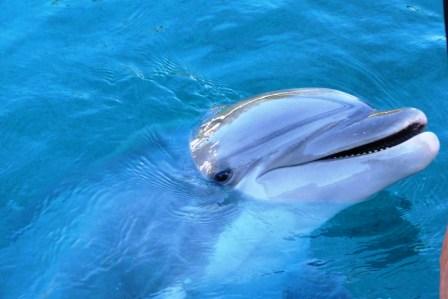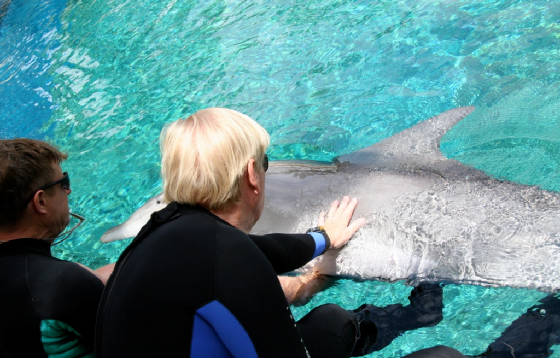|
SENSES

Hearing
The dolphin has an external, vertical ear "slit" located just posterior to each eye. The function of this slit
is somewhat controversial. Some believe it allows for sounds to enter into the auditory complex of the animal; others believe
it is a vestigial remnant of the external ear when the dolphin was living on land millions of years ago (see "evolution" within
this site) and has no part in the dolphn's ability to hear. In either case, it is agreed that some sound is picked up by that
part of the fatty mass within the panbone located (in part) within the inner ear.
The auditory cortex of the dolphin brain is highly developed, evidence of its complex hearing abilities. Dolphins hear
in a frequency range 7.5 times wider than the human. Hearing in the high frequencies is important for communication purposes.
Sounds coming to the dolphin are collected and "focused" by its 80-100 cone-shaped teeth, which act as a sort of antenna.
The focused sound vibrations are then transmitted to a fatty mass within the lower jawbone, also called the panbone. This
fatty mass provides what is called an "acoustic window" through which hearing may occur. The vibrations are then transferred
to the middle ear, then on to the inner ear bones: the hammer, anvil and stirrup. The auditory nerve passes from the inner
ear bones to the brain. This nerve is 3 times larger than man's, as it must transmit the complex echolocation and vocalization
signals that are part of the dolphin's everyday life. Vibrations, in the form of electrical impulses, pass
along this nerve to the brain. The brain then is able to interpret these impulses and process them as images.
Eyesight
Dolphins have excellent eyesight both above and below water. Special muscles in the eye are able to change the
shape of the lens to adjust for the difference between seeing an object below water (where corneal refraction
occurs) verses seeing an object in the air (where corneal refraction is not a factor). Since their eyes are located on
the side of the head, they have both monoscopic vision (they can process two different images at once) and stereoscopic vision
(they can see in 3D like man). The eyes focus at about 3-5 feet in front of the animal. They have blind spots directly behind
and above as well as directly in front of their rostrum. The eyes bear rods and long wavelength or L-cones to provide excellent
vision in low light conditions, but lack the short wavelength or S-cones necessary for color vision. It is believed they are
essentially color blind. Additionally, they are able to re-reflect light back to the retina so as to improve night vision. Their
excellent eyesight works in conjunction with their echolocation system in the processing of underwater visual information.
As shown in the photograph above, a common dolphin behavior is to surface and turn its body to one side, looking
at its environment with one eye. This allows the animal to examine a wide view and process this examination in detail.
Smell and Taste
As evidenced by the lack of olfactory lobes in the brain, dolphins don’t have a sense of smell (smells do
not travel well in water), but they do have taste buds when first born. Although these taste buds disappear after the first
few months of life, dolphins continue to show preferences for particular fish throughout their lives.

Touch
The dolphin
is a very tactile animal and responds to touch by other dolphins as well as by humans, even though its skin is 10-20
times thicker than the skin of land-dwelling mammals. Free nerve endings are very dense around the rostrum, pectoral fins
and genital area, providing a heightened sense of touch in these locations.
The outer layer of epidermis is continuously shed in small fragments (9 times faster than man sheds
his skin). This aids in its ability to swim fast and to shed parasites.
Relationships between dolphins, and between captive dolphins and their trainers, are
maintained and nurtured by physical contact. Here
I work with a dolphin trainer to "desensitize" a dolphin to contact. As this dolphin has not come in contact with me before,
this is an important opportunity for it to realize contact with an unknown person will not be harmful. Note my feet are
"hooked" around the dolphin's body to hold him in position while I place my hand on his body. This provides the maximum conditions
under which desentization may be attempted with the animal.
Site Content
Understanddolphins.com contains information condensed from a number of reputable technical sources,
peer reviewed journal articles, and respected dolphin research facilities, as well as from my personal experiences and
observations as a dolphin VIP Tour Guide and Educator.
I have made every attempt to support the information presented in this site with video and still
photographic images. On a regular basis I plan to produce more of these images and will continue to update the site with these
as well as with any new and scientifically verified information which becomes available.
|



